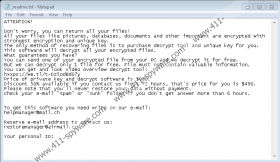Vvoa Ransomware Removal Guide
Vvoa Ransomware shows no mercy once it invades a vulnerable Windows system, as it immediately encrypts all personal files. Whether it is a work document, a project for school, or an important photo from your childhood, this malware encrypts it, and that ensures that you cannot read it anymore. The goal is not to destroy your files but to make you pay for a decryptor that, allegedly, would restore the files. Unfortunately, cybercriminals are schemers, and they are likely to promise a decryptor just so that you would give up your savings. That is how Vpsh Ransomware, Agho Ransomware, Sglh Ransomware, and many other infections from the STOP Ransomware family operate as well. They seem to have been built by the same cybercriminals/schemers, and that is why they are practically identical. We discuss the unique traits and how to delete Vvoa Ransomware in this report.
The most unique thing about Vvoa Ransomware might be the extension that it attaches to the files it corrupts. It is, of course, the “.vvoa” extension (the extension always matches the name of the threat), and the files with this extension will remain corrupted even if you remove it or change the filename completely. Along with the corrupted files, you should find the “_readme.txt” file. It is not unique in any way, and the same message has been presented by other clones of Vvoa Ransomware too. This message is meant to make you think that the attackers can offer a working decryptor. Even if they can, it does not mean that they would, and so we do NOT recommend contacting the attackers (you are instructed to email helpmanager@mail.ch or restoremanager@airmail.cc) and paying the ransom of $490. Whether this is a small or a big sum for you, it will go to the pocket of cybercriminals, who will use it to fund their luxury vacations or, worse, conduct new attacks against you and other Windows users.
So, your files are encrypted, and you are unlikely to obtain a decryptor from the attackers behind Vvoa Ransomware. What should you do, then? One option is to give up and admit defeat. Unfortunately, that is what most ransomware victims have to come to terms with. However, cybercriminals researching the STOP Ransomware family have built a free decryptor named ‘STOP Decryptor,’ and it appears to be capable of restoring files for some victims. Of course, the best solution is to replace the corrupted files with backup copies, but not all victims will have backups. After you remove Vvoa Ransomware, please take some time to research the best backup options because the safety of your personal files might depend on it in the future. Note that there are other ransomware families, and there are also other types of infections that can corrupt your personal files. If you want to protect them, always have copies at hand.
We can show you how to remove Vvoa Ransomware manually, but you need to think carefully if that is the right option for you. First of all, if you are inexperienced, you might fail to clean your system. Second, even if you are successful, what are you planning to do to keep the system safe? According to our research team, Vvoa Ransomware invades systems using misleading spam emails, malicious downloads, and RDP vulnerabilities. If your system is protected, even if you are tricked into executing the malware yourself, the security software should catch and delete it before any damage is done. Clearly, you need to employ legitimate anti-malware software for protection, but you can also use it for malware destruction. This software will automatically identify and remove all malware components that exist on your system now. So, which removal option are you going to choose?
How to delete Vvoa Ransomware
- Simultaneously tap Windows and R keys to access the Run dialog box.
- Type regedit into the box and then click OK to access Registry Editor.
- Go to HKEY_CURRENT_USER\Software\Microsoft\Windows\CurrentVersion\Run.
- Delete the value named SysHelper. Note that its value data reveals the location of the launcher.
- Simultaneously tap Windows and E keys to access the File Explorer.
- Enter %LOCALAPPDATA% into the field at the top to access the directory.
- Find the {unique name} folder with the launcher file inside. Delete it.
- Enter %USERPROFILE%\Local Settings\Application Data\ into the field at the top.
- Find the {unique name} folder with the launcher file inside. Delete it.
- Enter %WINDIR%\System32\Tasks\ into the field at the top and Delete the Time Trigger Task task.
- Exit all utilities and then Empty Recycle Bin.
- Install a malware scanner you trust and then run a complete system scan to check for leftovers.
Vvoa Ransomware Screenshots:


